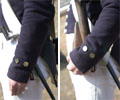SECTION II.
THE SOLDIER'S DRILL.
Back to PART II. Of Shouldered Arms.
LESSON 1. Principles of Shouldered Arms.
The recruit being placed as directed in the first lesson of the first part of this drill, the instructor will cause him to raise up the left hand without bending the wrist, the part of the arm from the elbow downwards only moving. The instructor shall then raise the firelock perpendicularly, and place it in the following manner.
The firelock in the left hand; the arm a little bent; the elbow back and touching the body, without pressing it; the palm of the hand placed firm against the exterior side of the butt, its exterior edge on the junction of the fingers with the palm; the heel resting between the for and middle fingers; the thumb above, in front; the two last fingers under the butt, which will be brought more or less back, according to the form of the soldier; so that the firelock seen from the front may appear always perpendicular, and that the motion of the thigh in marching may not derange its position; the rammer before the point of the shoulder; the right arm hanging naturally, as described in the first lesson of the first part of this drill.
 |
 |
 |
| Shoulder Arms |
Comparison: Position of the Soldier with and without arms. |
Note:
Position of the soldier "...the arms hanging naturally, the elbows close to the body; the palms of the hands a little turned forward; the little finger behind and touching the seam of the breeches;..."
Position under arms "... raise up the left hand without bending the wrist, the part of the arm from the elbow downwards only moving.
The instructor will endeavor to correct the natural defects in the position of recruits, before he delivers arms into their hands; so that the general appearance of the men may be uniform, without painful constraint.
Previous to proceeding with the second lesson, the instructor will make the recruits, with shouldered arms, practice the motions of turning the head to the right and left, and also the facings, to the right, to the left, and to the right about.
Next: LESSON II. The Manual Exercise |



